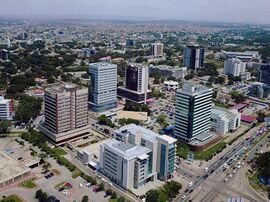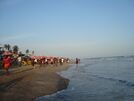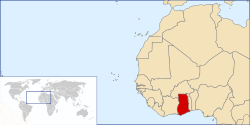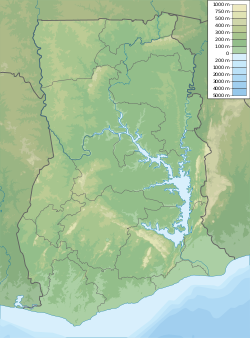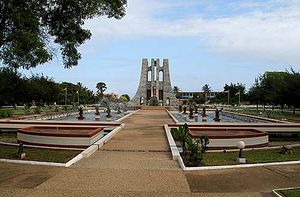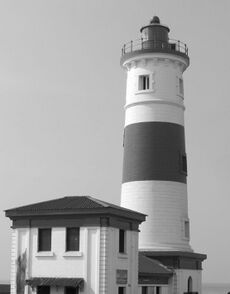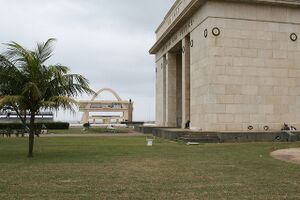أكرا
أكرا ( Accra ، /əˈkrɑː/; Ga: Ga or Gaga; توي: Nkran; Ewe: Gɛ; Dagbani: Ankara) هي عاصمة غانا وتطل على خليج غينيا، الذي هو جزء من المحيط الأطلسي.[5][6] وفي تعداد 2021، Accra Metropolitan District, 20.4 km2 (7.9 sq mi), had a population of 284,124 inhabitants, and the larger Greater Accra Region, 3،245 km2 (1،253 sq mi), had a population of 5,455,692 inhabitants.[7] In common usage, the name "Accra" often refers to the territory of the Accra Metropolitan District as it existed before 2008, when it covered 199.4 km2 (77.0 sq mi).[8] This territory has since been split into 13 local government districts: 12 independent municipal districts (total area: 179.0 km2) and the reduced Accra Metropolitan District (20.4 km2), which is the only district within the capital to be granted city status.[9] This territory of 199.4 km2 contained 1,782,150 inhabitants at the 2021 census,[10] and serves as the capital of Ghana, while the district under the jurisdiction of the Accra Metropolitan Assembly proper (20.4 km2) is distinguished from the rest of the capital as the "City of Accra".[11] أكرا هي أكبر مدن غانا ومركزها الإدارى والاقتصادى والاتصالي. أكــرا عاصمة غانا ومن كبريات مدنها، وتقع على الساحل الشمالي لخليج غينيا. وتشمل مرافق مواصلات أكرا سكة حديد ومطاراً دولياً. وتشمل صناعات المدينة إنتاج القرميد والطوب ومعالجة الماس والخشب. أقيمت جامعــة غانـا في ليجـون، وهي منطقـة سكنـية شمال المدينة. ويبلغ عدد سكان أكرا وضواحيها 1,420,065 نسمة منهم 964,879 نسمة في أكرا وحدها.
أنشأ شعب جا مدينة أكرا في منتصف القرن السابع عشر الميلادي، وكانت مركزا لتجار الرقيق في إفريقيا من القرن السادس عشر الميلادي حتى منتصف القرن التاسع عشر الميلادي. بنت الأمم الأوروبية التي كانت تتنافس على تجارة العبيد عدة حصون في مدينة أكرا. وقد أضاف خط السكة الحديدية ربط أكرا بالمناطق الداخلية عام 1923م إلى المدينة أهمية اقتصادية.
Formed from the merger of distinct settlements around British Fort James, Dutch Fort Crêvecoeur (Ussher Fort), and Danish Fort Christiansborg as Jamestown, Usshertown, and Christiansborg respectively, Accra served as the capital of the British Gold Coast between 1877 and 1957 and has since transitioned into a modern metropolis. The capital's architecture reflects this history, ranging from 19th-century colonial architecture to modern skyscrapers and apartment blocks.[12]
Accra is the Greater Accra Region's economic and administrative hub, and serves as the anchor of the larger Greater Accra Metropolitan Area (GAMA),[13] which is inhabited by about 4 million people, making it the thirteenth-largest metropolitan area in Africa. In 2020, the Globalization and World Cities Research Network think tank designated Accra as a "Gamma −" level global city, indicating a growing level of international influence and connectedness.[14]
أصل الاسم
The word Accra is derived from the Akan word Nkran meaning "ants", a reference to the numerous anthills seen in the countryside around Accra.[15][نشر ذاتي سطري?] The name specifically refers to soldier ants, and was applied to both the town and people by the Twi speakers.[16][17]
The name of Accra in the local Ga language is Ga or Gaga, the same name as that of the Ga people and a cognate with Nkran. The word is sometimes rendered with the nasalised vowels as Gã or Gãgã. Historian Carl Christian Reindorf confirmed this etymology, proposing a link between the martial qualities and migratory behaviour of the local ants and those of the Ga people. The link between the ethnonym and ants was explicitly reflected in the recognition of anthills as sacred places. Often ringed by sacred fences (aklabatsa), the tall red mounds dotting Accra's hinterland were seen as microcosms of human community and as nodal points between the known world and the world of the dead.[16]
The Ga used the reference to the invasive species of dark-red swarming ants to connote military prowess and their ancient conquest of Guang speakers residing in the Accra Plains.[18]
The name Ga is actually a cognate of the name Akan, one of a few words in which [g] corresponds to [k] in Akan.[19] Ga also gave its name to the Ga districts surrounding Accra.[20][نشر ذاتي سطري?]
The spelling Accra was given to Nkran by Europeans.[20] An earlier spelling used by the Danes was Akra.[21][22]
التاريخ
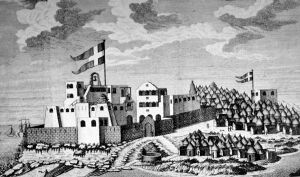
اُسست المدينة في أواخر القرن السابع عشر بواسطة شعب الگا Ga ويُشتق اسم المدينة من كلمة نكران ( Nkran) وتعني النمل في إشارة إلى مستعمرات النمل الكثيرة الموجودة بالمناطق الريفية المحيطة بأكرا، كانت المدينة قديماً مركزا للتجارة مع البرتغاليين الذين بنوا حصناً في المدينة ثم تبعهم السويديون و الألمان والفرنسيون والبريطانيون.
كان سهل أكرة يضم عدداً من القرى يسكنها أفراد قبيلة «گا» Ga، المتفرعة عن مستوطنة أياسو Ayaso التي استقرت على مسافة نحو 24 كم إلى الشمال من ذلك الموقع.
والبرتغاليون أول من نزل ساحل أكرة من الأوربيين عام 1482، وفي المدة بين 1650 -1680 أقام التجار الهولنديون حصناً لهم على الساحل عرف باسم حصن كرِڤكور Fort Crèvecœur. وأقام الإنكليز حصن جيمس Ft. James إلى الشرق منه، وأنشأ الدنماركيون قلعة دعوها كريستيانزبورگ Christiansborg. وفي تلك الأثناء دمرت الحروب المحلية مستوطنات أياسو وگا مما دفع سكانها إلى التحرك باتجاه الساحل والاستقرار حول تلك الحصون التجارية للمتاجرة مع الأوربيين، وتكوَّنت نتيجة لذلك ثلاث بلدات ساحلية كانت نواة مدينة أكرة الحديثة.
تطورت أكرة نتيجة عاملين اثنين هما: التجارة أولاً، ونقل عاصمة مستعمرة ساحل الذهب البريطانية من الكاب Cap إليها عام 1898 ثانياً (تخلى الدنماركيون ثم الهولنديون عن معقليهم لبريطانية في عامي 1850 و1872) وقد حاول مجلس المدينة في عام 1898 إدخال تحسينات على مخططها فلم ينجح تماماً، وأدت الأوضاع غير الصحية إلى انتشار الطاعون عام 1907، بيد أن المشروعات اللاحقة الرامية إلى تطوير المدينة التي نفذتها إدارة المستعمرة في العشرينات من القرن العشرين انتهت إلى نمو المدينة نمواً مطرداً، وزاد في نجاحها تزايد السكان من 60.627 نسمة عام 1931 إلى 133.192 نسمة عام 1944، وقد بلغ عددهم 949.100 نسمة في إحصاء عام 1988.
After World War II
In the years following World War II, the neighbourhoods of Ridge and Cantonments were planned as low-density developments for Europeans, while many rural migrants settled in neighbourhoods which had not yet been incorporated into Accra's municipal boundary, such as Nima and surrounding areas.[بحاجة لمصدر] Thus, the development of these neighbourhoods was unregulated by the government, creating a crowded and jumbled shanty-town landscape.[بحاجة لمصدر]
Another area of Accra that took shape at this time was the central business district (CBD). More administrative buildings were built on High Street, forming a massive judicial/administrative complex. Additionally, the expansion of the economy led to many more commercial buildings being built in the CBD.[بحاجة لمصدر]
In 1944, Accra's city planner Maxwell Fry devised a town plan, which was revised in 1958 by B.D.W. Treavallion and Alan Flood. Although the Fry/Trevallion plan was never followed through, it illustrated the British vision of how Accra should develop.[بحاجة لمصدر]
In 1948, Ghana remained a colony of Great Britain following World War II. The chief of Osu Alata, Nii Kobina Bonney III, had set up a boycott of European goods across the country due to the rise of prices for essential commodities.[23] At the same time veterans of the war were fighting for their benefits and promised pay.[24] Unarmed ex-servicemen organized a march on Christiansborg Castle, Accra on February 28, 1948. Their plan was to hand a petition to the colonial governor demanding they receive their pay and benefits. Before reaching the castle, the veterans were fired upon, after being ordered by the colonial police chief to disperse. Three of the leaders of the demonstration were killed, including Sergeant Nii Adjetey, who now has a memorial in Accra.[بحاجة لمصدر]
Fry/Treavallion plan
قالب:Unreferencedsect In the Fry/Treavallion plan, a reorganization of the CBD was called for, as well as the development of the coastal region of the city. To reorganize the CBD, the planners decided to superimpose a tight street grid north of Fort Ussher.
To the east of this newly organized CBD, the planners hoped to preserve a broad, open space for a restaurant, country club, and polo and cricket fields. Additionally, the British planners intended to build large numbers of public squares, fountains, and ornamental pools and statues throughout the city, as well as a vast Parliament Complex in the city centre. Lastly, the Fry/Treavallion plan included plans to make the coastal region an extension of the exclusive European neighbourhood of Victoriaborg, and to create a recreational preserve for the elite. However, the British Gold Coast ended before the Fry/Treavallion plan was enacted.
Nkrumah Plan
When Kwame Nkrumah became Ghana's first post-independence Prime Minister in 1957, he created his own plan for Accra's development.[25] Instead of creating spaces to serve the elite, Nkrumah sought to create spaces to inspire pride and nationalism in his people and people throughout Africa.[بحاجة لمصدر]
Rather than creating ornamental fountains and a large Parliament complex, Nkrumah decided to build landmarks such as Independence Square, the State House, and the Organisation of African Unity building, and to refurbish Christianborg Castle. Nkrumah decided to leave the Atlantic coastal region undeveloped, so as to not detract attention from the Community Centre or Independence Square, lending both spaces symbolic significance.[بحاجة لمصدر] The Nkrumah plan did not emphasise order nearly as much as the Fry/Treavallion plan did; whereas the British plan strove to lessen crowding in the commercial district and help relieve the overcrowding of neighbourhoods bordering the CBD, the Nkrumah plan allowed for continued compression of commercial establishments into the CBD, as well as increased migration into Jamestown.[بحاجة لمصدر]
The modern city is centred on the original British, Danish, and Dutch forts and their surrounding communities: Jamestown near the British James Fort, Osu near the Danish fort of Christiansborg (now Osu Castle), and Ussherstown near the Dutch Ussher fort.
Tourist attractions include the National Museum of Ghana, the Ghana Academy of Arts and Sciences, the National Archives of Ghana and Ghana's central library, the National Theatre, the Accra Centre for National Culture, and the Jamestown Lighthouse.
The Parliament, Supreme Court of Ghana, Black Star Square and the Bank of Ghana are also located in Accra.
The city is also a transportation hub, home to the Kotoka International Airport, and railway links to Tema, Sekondi-Takoradi and Kumasi. Accra has become a location for national and international business conferences, such as the BarCamp Ghana series, organised by GhanaThink Foundation.[26]
السكان
The period between 1960 and 1970 saw rapid industrialization and expansion in Accra's manufacturing and commercial sectors. This contributed to high rural-urban migration to the city, and consequently a high population growth rate.[27] The stagnation of the Ghanaian economy during the 1970s slowed the growth of Accra's population, as shown by the falling growth rate of the 1970–1984 intercensal years. Later, however, the decline in agriculture in rural communities in Ghana and rising industrialization in urban regions, coupled with the late-1980s boom in the service sector, once again propelled immigration to Accra. The primacy of the Accra Metropolitan Area as the Greater Accra region's administrative, educational, industrial and commercial centre continues to be the major force for its population growth, with immigration contributing to over 35% of the Accra's population growth.
Distribution and density
قالب:Unreferencedsect The gross density of population for the Accra Metropolitan Area in 2000 was 10.03 persons per hectare, compared to 6.23 per hectare in 1970. The highest densities were recorded in the Accra Metropolitan Assembly, with an overall average of 69.3 persons per hectare. At the community level, densities exceeding 250 persons per hectare occurred mostly in the immigrant and depressed areas in the oldest parts of Accra, such as Accra New Town, Nima, Jamestown and Usshertown. In higher-income areas, densities ranged between 17.5 and 40 persons per hectare.
Population distribution by age and gender
Accra's population is a very youthful one, with 56% of the population being under 24 years of age. This predominance of young people is not expected to decline in the foreseeable future. Fifty-one percent (51%) of the population are females, and the remaining 49% males. This gives a males-to-females ratio of 1:1.04. The greater number of females is a reflection of the nationwide trend, where the estimated ratio of males to females is 1:1.03.[28]
Migration
Decentralization is expected to reduce the migration rates in Accra. An assessment of the extent of migration to Accra, based on present locality and gender, reveals that 45% of residents in Accra are African immigrants from countries across the African continent.
Housing
قالب:Unreferencedsect Parts of Central Accra comprise a mixture of very low-density development with under-used service infrastructure on the one hand, high-density development and overstretched infrastructure services on the other. The growth of Accra has led to the neglect of some of the old settlements, whilst efforts are being made to provide the newly developing suburban areas with services and infrastructure to cater for the needs of the middle-income earners. Peripheral residential development in Accra barely has sufficient infrastructure to support it. There are also large numbers of uncompleted houses, interspersed with pockets of undeveloped land, which are often subject of litigation, due to the inability of organisations and individuals who own them to complete or develop them due to lack of funds. Housing can be grouped into three broad categories: the low-income, middle-income and high-income areas. The low-income housing areas comprise Osu, Jamestown, Adedenkpo, Chorkor, La, Teshie, Nungua, Sukura, Kwashieman, Odorkor, Bubiashie, Abeka, Nima, Maamobi and Chorkor. Altogether, these areas accommodate about 58% of Accra's total population. Most of Accra's informal businesses are located in low-income areas.
Almost all low-income areas are built up with little room for expansion. This is particularly so in the areas of the inner city. The middle-income areas of Accra are predominantly populated by Ghanaian citizens and business, administrative and professional families. Much of the housing in these areas has been provided by state, parastatal and private sector organisations and individuals. The middle-income areas include Dansoman Estates, North Kaneshie Estates, Asylum Down, Kanda Estates, Abelempke, Achimota, Adenta and Tesano. Usually, these areas, unlike the low-income areas, are planned developments, but are in need of infrastructure services. Building materials and general housing conditions are of better quality. The middle-income group comprises 32% of the city's population of which are Ghanaian citizens make up. The high-income areas provide housing for the remaining 10% of the population of which Ghanaian citizens also make up. They include areas like North Ridge and West Ridge, Ringway Estates, north Labone Estates, Airport Residential Area, Roman Ridge, East Legon.
These areas are all planned and have well developed infrastructure with spacious and landscaped ground in sharp contrast with, particularly, the low-income areas. Buildings are usually built with sandcrete blocks, and have walls and roofed with aluminium, or asbestos roofing sheets. There are also high-income peripheral areas like Haatso, Kwabenya, Pokuase, Adenta, Taifa, Mallam, where development of engineering infrastructure is not yet complete. These areas developed ahead of infrastructure, however the Achimota-Ofankor controlled-access highway was scheduled to open in May 2012,[needs update][29][30] dual carriageway road construction was also due to be completed in 2012.[needs update] In total, 84.4% of all houses in the Accra Metropolitan Area have their outside walls made up of cement. Similarly, houses found within Accra have 99.2% of their floor materials made up of cement.
الدين
أكثر سكان أكرة من المسيحيين البروتستنت والكاثوليك (نحو 62%)، ونسبة المسلمين فيها نحو 16%، ويعتنق الباقون الديانات الإفريقية التقليدية أو لايعتنقون أي دين.
الطقس
| متوسطات الطقس لأكرا | |||||||||||||
|---|---|---|---|---|---|---|---|---|---|---|---|---|---|
| شهر | يناير | فبراير | مارس | أبريل | مايو | يونيو | يوليو | أغسطس | سبتمبر | اكتوبر | نوفمبر | ديسمبر | |
| متوسط العظمى °ف (°م) | 89.8 (32) | 90.9 (33) | 90.5 (33) | 90.0 (32) | 88.2 (31) | 84.7 (29) | 83.3 (29) | 82.4 (28) | 84.2 (29) | 86.9 (31) | 88.9 (32) | 89.1 (32) | |
| متوسط الصغرى °ف (°م) | 74.1 (23) | 75.4 (24) | 75.4 (24) | 75.6 (24) | 75.0 (24) | 73.6 (23) | 72.5 (23) | 72.0 (22) | 72.3 (22) | 75.0 (24) | 74.3 (24) | 74.1 (23) | |
| هطول الأمطار بوصة (mm) | 0.4 (10.9) | 0.9 (21.8) | 2.2 (57.1) | 3.8 (96.8) | 5.2 (131.2) | 8.7 (221.0) | 2.6 (66.0) | 1.1 (28.0) | 2.7 (67.8) | 2.5 (62.4) | 1.1 (27.7) | 0.6 (16.1) | |
| المصدر: worldweather.org [31] 5 Jan 2008 | |||||||||||||
الإقتصاد
الأنشطة الإقتصادية في أكرا هى الاتصالات و البناء و المواصلات و الخدمات المالية الحكومية والزراعة وخصوصاً صيد الأسماك , معظم القدرات الصناعية تقع في منطقة العاصمة.
In 2008, the World Bank estimated that Accra's economy only constituted around US$3 billion of Ghana's total gross domestic product (GDP).[32] The economically active population of Accra is estimated to be 823,327.
Accra is a centre for manufacturing, marketing, finance, insurance, and transportation. Its financial sector incorporates a central bank, nine commercial banks (with 81 branches), four development banks (with 19 branches), four merchant banks (with seven branches), three discount houses, one home finance mortgage bank, multiple building societies, Ghana Stock Exchange, foreign exchange bureaus, finance houses, insurance companies, insurance brokerage firms, two savings and loans companies, and numerous real estate developers, with industrial sites and residential developments.[33][34] The road network in the Accra Metropolitan Area totals 1،117 كيلومتر (694 mi) in length.
There are over 50,506 identified residential properties in Accra, and about 4,054 commercial/industrial/mixed properties, with a total rateable value of GH¢13,849,014.[35] There are also supermarkets, 36 facilities for both on–street and off-street parking, and shopping malls, as well as several facilities for sports and recreation.
قطاعات الاقتصاد
The sectors of Accra's economy consist of the primary, secondary (manufacturing, electricity, gas, water, construction) and tertiary sectors (supermarkets, shopping malls, hotel, restaurant, transportation, storage, communication, financial intermediation, real estate service, public administration, education, health and other social services). The tertiary service sector is the city's largest, employing about 531,670 people. The second-largest, the secondary sector, employs 22.34% of the labour force, or around 183,934 people. 12.2% of the city's workforce are reportedly unemployed, totalling around 114,198 people.[35]
القطاع الأساسي
Accra's smallest economic sector, the primary sector, employs approximately 91,556 people. The predominant economic activities are fishery and urban agriculture, with fishery accounting for 78% of production labour. Urban agriculture in Accra centres on the growth of vegetables, several crops and poultry. The fishery industry is the most important sub-sector, with 10% of the catch being exported and the rest consumed locally. The industry is characterised by extreme seasonableness, operating primarily between June and September. Although most deep-water Atlantic fishing around Accra takes place in the June–September period, fishery operations take place close to the shore throughout the year, and there are clear indications of the depletion of fish stocks in the near future. Fishing operations are most prominent at the Jamestown, La, Teshie, Nungua and Chorkor fishing shores.
معالم المدينة
تجمع أكرة في بنائها الطراز الأوربي والفن المعماري الإفريقي. ويعيش السكان في أحياء واضحة المعالم تدل أبنيتها على عصرها ومستوى سكانها. وأكثر البيوت التقليدية الإفريقية من طابق واحد مستطيلة الشكل ذات أسقف هرمية تتجمع حول فناء يتوسطها. أما المباني الأوربية الطراز فتتألف من طابقين بشرفات فسيحة على أعمدة لها صهاريج في الأفنية الخلفية لجمع مياه المطر، إضافة إلى الدور الفخمة المشيدة على الطراز الحديث في بعض الأحياء الحديثة. وتتركز الأبنية المتعددة الطوابق في الوسط التجاري الموجود على تخوم بلدة جيمس تاون، وفيه المكاتب الرئيسية للمصارف والشركات الكبرى التي تعمل بالتجارة والصناعة والتأمين ومؤسسات البريد والكهرباء والأسواق التجارية الكبيرة، إضافة إلى المحكمة العليا ومبنى المكتبة المركزية، وتقوم المكاتب الحكومية والإدارية ومكاتب سلطة نهر الفولتا في الوسط بين بلدة أوشر Ussher (أكرة الهولندية) وكريستيانزبورگ. أما المنطقة الصناعية فتقع إلى الغرب قليلاً عند حيل كورل حيث مصانع تجميع السيارات والألبسة والمواد الغذائية والمشاغل المختلفة، وإلى الغرب من حيل كورل يقوم أكبر مستشفيات البلاد وأحسنها تجهيزاً، وكلية الطب، وفوق إحدى التلال شمالي أكرة تقوم جامعة غانة. وفي المدينة ثلاث كاتدرائيات ومتحف وطني ومركز للبحوث العلمية والصناعية وأكاديمية غانا للفنون والعلوم، إضافة إلى عدد كبير من النوادي والمدارس والفنادق ومراكز الخدمات الموزعة في أرجائها، وتخترق المدينة شوارع معبدة تنطلق من المركز ويربط بينها طريق محلق (دائري)، ويربطها مع بقية المدن طرق معبدة، وثمة خط حديدي يربط أكرة بمدينة كوماسي، وخط آخر يربطها بمرفئها الجديد تيما Tema الذي يقع على مسافة 26 كم إلى الشرق. وفي أكرة تلتقي خطوط الطيران الداخلية وفيها المطار الدولي الوحيد في غانة.
تحتوى المدينة على العديد من المعالم المميزة لها مثل المتحف الوطنى لغانا ، اكاديمية غانا للفنون و العلوم، مبنى الأرشيف القومى لغانا ، المكتبة المركزية،و ايضاً قلعة اوسو او كريستيان بورج ( Christianborg or Osu Castle) ، المقر الحكومى و الذى قام الدنماركيون ببنائه في القرن السابع عشر، المسرح القومى، مركز أكرا للثقافة الوطنية، منارة، استاد اوهينى دجان( Ohene Djan)، مركز أكرا الدولى للمؤتمرات، النصب التذكارى لكوامى نكروما بوسط أكرا.
وكذلك تتصل عالميا أكرا عن طريق مطار كوتوكا الدولي. [36]
التعليم
الجامعات
University of Ghana is located 13 كيلومتر (8.1 mi) north of the city centre at Legon. A number of other public and private universities and tertiary institutions have since been founded in Accra, some of which are listed below.
| Institution | Location | Public/Private | Affiliation |
|---|---|---|---|
| University of Ghana (Legon) | Legon | Public | |
| Accra Institute of Technology (AIT) | Cantonments | Private | Kwame Nkrumah University of Science and Technology |
| Regional Maritime University (RMU) | Nungua | Private | University of Ghana |
| Ghana Telecom University College (GTUC) | Tesano | Private | |
| Islamic University College (ICUG) | East Legon | Private | University of Ghana |
| Knutsford University College (Knutsford) | East Legon | Private | University of Ghana |
| Methodist University College (MUCG) | Dansoman | Private | University of Ghana |
| Regent University College of Science and Technology (Regent) | Mataheko | Private | Kwame Nkrumah University of Science and Technology |
| Ashesi University (Ashesi) | Berekuso | Private | University of Cape Coast |
| Heritage Christian College | Amasaman | Private | Kwame Nkrumah University of Science and Technology |
| Central University College (Central) | Mataheko/Miotso | Private | University of Cape Coast |
| Zenith University College (ZUC) | La, Trade Fair | Private | University of Cape Coast |
| Ghana Institute of Journalism (GIJ) | Ridge | Public | University of Ghana |
| Accra Technical University(ATU) | Tudu | Public | |
| Advanced Business University College (ABUC) | Kaneshie | Private | University of Education, Winneba |
| Ghana Institute of Management and Public Administration (GIMPA) | Achimota | Public | |
| The University of Professional Studies (UPS) | Legon | Public | |
| National Film and Television Institute (NAFTI) | Cantonments | Public | University of Ghana |
| Valley View University (VVU) | Oyibi | Private | |
| African University College of Communications (AUCC) | Adabraka | Private | University of Ghana |
| University of Professional Studies, Accra (UPSA) | East-Legon | Public | Accra |
| Academic City University College (ACUC) | Haatso | Private | |
| Pentecost University (Pentvars) | Sowutuom | Private | |
| Wisconsin International University College, Ghana | North Legon | Private | |
| Webster University, Ghana | East Legon | Private |
المدن الشقيقة
لأكرا أربع مدن شقيقة رسمياً، حسب Sister Cities International:[37]
| المدينة | Province / Region / الولاية | البلد | السنة | مرجع |
|---|---|---|---|---|
| گاوتنگ | [38] | |||
| سترلنگ | كنتيكت | [37] | ||
| District of Columbia | 2006 | [39] | ||
| كلومبيا | كارولينا الجنوبية | [40] | ||
| كلومبس | أوهايو | 2015 | ||
| تشاتانوگا | تنسي | 2024 | [41] |
معرض الصور
انظر أيضاً
المصدر
- ^ "Physical And Natural Environment Boundary/ Administrative Area". ama.gov.gh. Archived from the original on 5 July 2015.
{{cite web}}: Unknown parameter|deadurl=ignored (|url-status=suggested) (help) - ^ "Boundary and Administrative Area". Ghanadistricts.com. Archived from the original on 11 July 2011. Retrieved 22 July 2010.
{{cite web}}: Unknown parameter|deadurl=ignored (|url-status=suggested) (help) - ^ "Archived copy" (PDF). Archived from the original (PDF) on 3 September 2017. Retrieved 14 January 2018.
{{cite web}}: Unknown parameter|dead-url=ignored (|url-status=suggested) (help)CS1 maint: archived copy as title (link) - ^ "Citypopulation.de". Thomas Brinkhoff. Archived from the original on 20 December 2016. Retrieved 25 April 2017.
{{cite web}}: Unknown parameter|deadurl=ignored (|url-status=suggested) (help) - ^ "Walking You Through Accra's Beautiful Attractions". Peace FM Online. Jan 31, 2022. Archived from the original on 31 January 2022. Retrieved 31 January 2022.
- ^ Amponsah, Owusu; Takyi, Stephen Appiah (2023-01-31). "Accra is congested, but relocating Ghana's capital is not the only option". The Conversation (in الإنجليزية). Retrieved 2023-08-18.
- ^ خطأ استشهاد: وسم
<ref>غير صحيح؛ لا نص تم توفيره للمراجع المسماة2021_census - ^ Sum of the land areas of Accra Metropolitan District, Ablekuma Central Municipal District, Ablekuma North Municipal District, Ablekuma West Municipal District, Ayawaso Central Municipal District, Ayawaso East Municipal District, Ayawaso North Municipal District, Ayawaso West Municipal District, Korle Klottey Municipal District, Krowor Municipal District, La Dadekotopon Municipal District, Ledzokuku Municipal District, and Okaikoi North Municipal District, as per the 2021 census, page 80: [1].
- ^ The country's first president, Kwame Nkrumah, declared the Accra Town Council, as it was referred to at the time, a city.
- ^ Sum of the populations of Accra Metropolitan District, Ablekuma Central Municipal District, Ablekuma North Municipal District, Ablekuma West Municipal District, Ayawaso Central Municipal District, Ayawaso East Municipal District, Ayawaso North Municipal District, Ayawaso West Municipal District, Korle Klottey Municipal District, Krowor Municipal District, La Dadekotopon Municipal District, Ledzokuku Municipal District, and Okaikoi North Municipal District, as per the 2021 census, page 80: [2].
- ^ "Our Background – AMA". Archived from the original on 10 January 2018. Retrieved 14 January 2018.
- ^ "Accra — Ghana Articles". Archived from the original on 15 August 2016. Retrieved 24 June 2016.
- ^ "Environmental and Structural Inequalities in Greater Accra". The Journal of the International Institute. Archived from the original on 19 October 2012. Retrieved 22 July 2010.
- ^ "The World According to GaWC 2020". GaWC – Research Network. Globalization and World Cities. Archived from the original on 24 August 2020. Retrieved 31 August 2020.
- ^ Akuamoa, Geoffrey (18 March 2013). "The Gas". KWAME, THE LAST SLAVE FROM WEST AFRICA (in الإنجليزية). Lulu.com. ISBN 978-1-291-35746-2. Archived from the original on 17 February 2022. Retrieved 24 October 2020.قالب:Self-published source
- ^ أ ب Parker, John (1 January 2000). Making the Town: Ga State and Society in Early Colonial Accra (in الإنجليزية). ABC-CLIO, LLC. p. 6. ISBN 978-0-325-00190-6. Archived from the original on 17 February 2022. Retrieved 24 October 2020.
- ^ Views of Africa (in الإنجليزية). Encyclopaedia Britannica, Inc. 1 April 2012. p. 12. ISBN 978-1-61535-571-6. Archived from the original on 17 February 2022. Retrieved 24 October 2020.
- ^ Rucker, Walter C. (28 September 2015). Gold Coast Diasporas: Identity, Culture, and Power (in الإنجليزية). Indiana University Press. p. 30. ISBN 978-0-253-01701-7. Archived from the original on 17 February 2022. Retrieved 24 October 2020.
- ^ Dakubu, Mary Esther Kropp (1 January 1997). Korle Meets the Sea: A Sociolinguistic History of Accra (in الإنجليزية). Oxford University Press. p. 113. ISBN 978-0-19-506061-4. Archived from the original on 17 February 2022. Retrieved 24 October 2020.
- ^ أ ب Ntiamoah, Eric Maclean (1 January 2008). The City of Accra – A Pictorial Visit (in الإنجليزية). AuthorHouse. p. 4. ISBN 978-1-4343-5860-8. Archived from the original on 17 February 2022. Retrieved 24 October 2020.قالب:Self-published source
- ^ Harries, Patrick; Maxwell, David (20 July 2012). The Spiritual in the Secular: Missionaries and Knowledge about Africa (in الإنجليزية). Wm. B. Eerdmans Publishing. p. 73. ISBN 978-0-8028-6634-9. Archived from the original on 17 February 2022. Retrieved 24 October 2020.
- ^ Jenkins, Paul (1 January 1998). The Recovery of the West African Past: African Pastors and African History in the Nineteenth Century : C.C. Reindorf & Samuel Johnson : Papers from an International Seminar Held in Basel, Switzerland, 25–28th October 1995 to Celebrate the Centenary of the Publication of C.C. Reindorf's History of the Gold Coast and Asante (in الإنجليزية). Basler Afrika Bibliographien. p. 86. ISBN 978-3-905141-70-2. Archived from the original on 17 February 2022. Retrieved 24 October 2020.
- ^ Nyadzi, Ralph (22 April 2019). "The Causes and Effects of the 1948 Accra Riots in Ghana". Cegast Academy. Archived from the original on 8 May 2023. Retrieved 2 October 2023.
{{cite web}}: CS1 maint: bot: original URL status unknown (link) - ^ PRAAD. "The Riots of 28th February 1948". Public Records and Archives AdministrationDepartment. Marichael Company Limited. Retrieved 2 October 2023.
- ^ Roman Adrian Cybriwsky, Capital Cities around the World: An Encyclopedia of Geography, History, and Culture, ABC-CLIO, USA, 2013, p. 5
- ^ "Accra Conferences". Archived from the original on 17 October 2011.
- ^ "A repository of all districts in the republic of Ghana". Ghana Districts. Archived from the original on 11 July 2011. Retrieved 5 August 2010.
- ^ Mba, Chuks J. (29 September 2010). "Population Ageing in Ghana: Research Gaps and the Way Forward". Journal of Aging Research. 2010: 672157. doi:10.4061/2010/672157. ISSN 2090-2204. PMC 3003962. PMID 21188229.
- ^ "Achimota-Ofankor Road To Open To Traffic in May". graphic.com.gh. Daily Graphic. 14 March 2012. Archived from the original on 12 May 2016. Retrieved 22 April 2016 – via Modern Ghana.and the Awoshie-Pokuase
- ^ "Ghana: Awoshie-Pokuase Road Projet" (PDF). afdb.org. Archived (PDF) from the original on 23 July 2013.
- ^ World Weather Information Service - Accra
- ^ http://www.worldbank.org/afr/wps/wp110.pdf Archived 12 فبراير 2011 at the Wayback Machine World Bank Africa Region Working Paper Series 110 (PDF). Retrieved 15 October 2011.
- ^ "Mantse Ankrah the Accra landlord is coming". Ghana Business Media. January 2012. Archived from the original on 23 July 2013.
- ^ Oil Revenue Archived 3 أغسطس 2012 at the Wayback Machine. ghanaoilwatch.org.
- ^ أ ب "A repository of all districts in the republic of Ghana". Ghana Districts. Archived from the original on 11 July 2011. Retrieved 5 August 2010.
- ^ Ghana Civil Aviation Authority | Home
- ^ أ ب "SCI: Sister City Directory". Sister-cities.org. Archived from the original on 31 August 2010. Retrieved 5 August 2010.
- ^ "Johannesburg's Sister Cities". joburg.org.za. Archived from the original on 1 February 2014. Retrieved 14 February 2014.
- ^ "DC Sister Cities". os.dc.gov. Archived from the original on 2 July 2017. Retrieved 8 August 2017.
- ^ "Columbia's Sister Cities". columbiawac.org. Archived from the original on 8 September 2013. Retrieved 14 February 2014.
- ^ "Chattanooga's seventh sister city, Accra, Ghana, the first from the continent of Africa". Local 3 News. February 12, 2024.
وصلات خارجية
- "Accra Night Life Still Dey Pap", Afrosages.com, 22 January 2020
- Pages using gadget WikiMiniAtlas
- CS1 errors: unsupported parameter
- CS1 maint: bot: original URL status unknown
- Short description is different from Wikidata
- Coordinates on Wikidata
- Articles containing Ga-language text
- Pages using Lang-xx templates
- Articles containing توي-language text
- Articles containing Dagbani-language text
- All articles with self-published sources
- Articles with self-published sources from February 2020
- Pages with plain IPA
- Articles with hatnote templates targeting a nonexistent page
- مقالات ذات عبارات بحاجة لمصادر
- Wikipedia articles in need of updating from December 2014
- All Wikipedia articles in need of updating
- غانا
- عواصم أفريقيا
- مدن ساحلية
- أكرا
- أماكن مأهولة في منطقة أكرا الكبرى
- أماكن مأهولة تأسست في القرن 15
- أماكن ساحلية مأهولة في غانا
- مستعمرات برتغالية سابقة
- مستعمرات هولندية سابقة
- مستعمرات دنماركية سابقة
- Port cities in Africa
- عواصم إقليمية في غانا
- ساحل الذهب الهولندي
- ساحل الذهب البرتغالي
